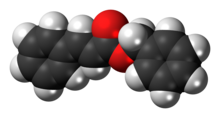Benzyl cinnamate
Appearance
(Redirected from Cinnamein)

| |

| |
| Names | |
|---|---|
| Preferred IUPAC name
Benzyl (2E)-3-phenylprop-2-enoate | |
| Other names
Benzyl cinnamate
Cinnamein Benzyl cinnamoate Benzyl 3-phenylpropenoate 3-Phenyl-2-propenoic acid phenylmethyl ester Cinnamic acid benzyl ester | |
| Identifiers | |
3D model (JSmol)
|
|
| ChemSpider | |
| ECHA InfoCard | 100.002.827 |
PubChem CID
|
|
| UNII | |
CompTox Dashboard (EPA)
|
|
| |
| |
| Properties | |
| C16H14O2 | |
| Molar mass | 238.286 g·mol−1 |
| Appearance | White to pale yellow solid[1] |
| Melting point | 34–37 °C (93–99 °F; 307–310 K)[2] |
| Boiling point | 195–200 °C (383–392 °F; 468–473 K) 5 mmHg[2] |
| Insoluble[1] | |
| Solubility in ethanol | 125 g/L |
| Solubility in glycerin | Insoluble |
| Solubility in propylene glycol | Insoluble |
Except where otherwise noted, data are given for materials in their standard state (at 25 °C [77 °F], 100 kPa).
| |
Benzyl cinnamate is the chemical compound which is the ester derived from cinnamic acid and benzyl alcohol.
Natural occurrence
[edit]Balsam is the major producer of benzyl cinnamate.[3] It is used as an ingredient in the medicated cream product Sudocrem.[4]
Uses
[edit]It is used as a flavoring agent.[3]
It is used pharmaceutically as an antibacterial and antifungal.[5]
References
[edit]- ^ a b "Specifications for Flavourings". Food and Agriculture Organization. Archived from the original on 2015-09-24. Retrieved 2014-02-20.
- ^ a b "Benzyl cinnamate". Sigma-Aldrich.
- ^ a b George A. Burdock (2010), "BENZYL CINNAMATE", Fenaroli's Handbook of Flavor Ingredients (6th ed.), CRC Press, pp. 147–148
- ^ "Sudocrem Antiseptic Healing Cream - Summary of Product Characteristics (SmPC) - (emc)". www.medicines.org.uk. Retrieved 11 June 2021.
- ^ Korošec, B.; Sova, M.; Turk, S.; Kraševec, N.; Novak, M.; Lah, L.; Stojan, J.; Podobnik, B.; Berne, S.; Zupanec, N.; Bunc, M.; Gobec, S.; Komel, R. (2014). "Antifungal activity of cinnamic acid derivatives involves inhibition of benzoate 4-hydroxylase (CYP53)". Journal of Applied Microbiology. 116 (4): 955–966. doi:10.1111/jam.12417. ISSN 1365-2672. PMID 24314266.
External links
[edit]- Benzyl cinnamate at National Library of Medicine's Toxicology Data Network
